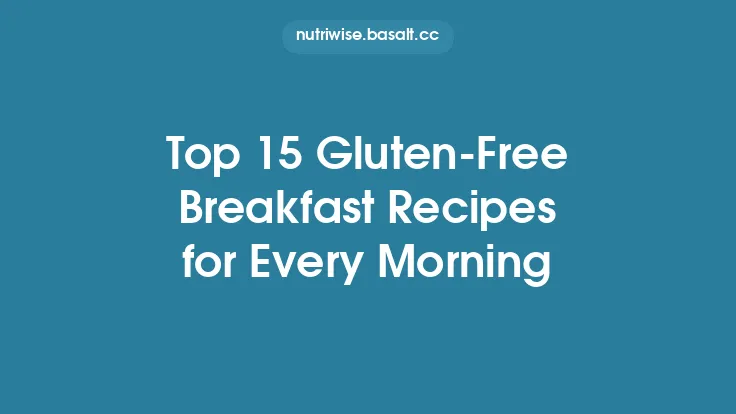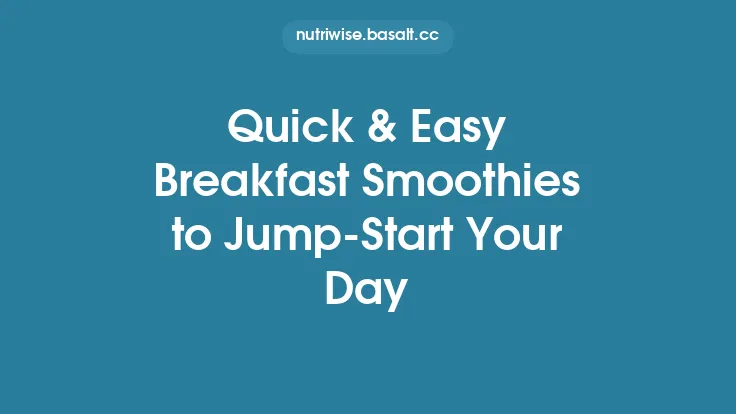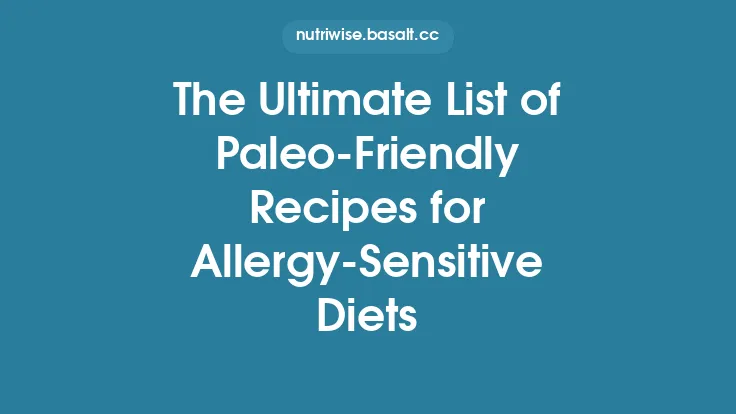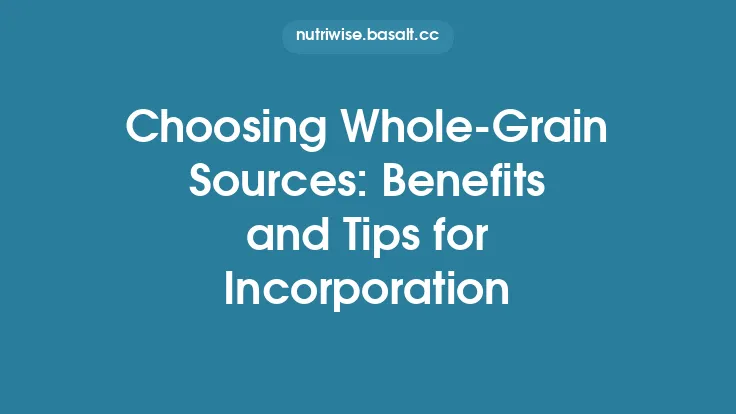Egg‑free breakfasts can be just as satisfying, nourishing, and protein‑dense as their egg‑based counterparts. For anyone navigating food allergies, intolerances, or simply looking to diversify their morning routine, there are plenty of wholesome options that deliver the muscle‑building and satiety‑boosting benefits of protein without relying on eggs. Below, we explore the science behind non‑egg protein sources, how to assemble a balanced plate, and a collection of detailed recipes that can be tailored to a wide range of dietary needs.
Understanding Common Protein Sources Beyond Eggs
Legumes and Pulses
Beans, lentils, and peas are among the most versatile plant‑based proteins. A half‑cup of cooked lentils provides roughly 9 g of protein, along with fiber, iron, and folate. While they are not complete proteins on their own (they lack sufficient methionine), pairing them with a grain or seed can create a full amino‑acid profile.
Dairy‑Based Options
For those who tolerate dairy, Greek yogurt, cottage cheese, and kefir are excellent sources of high‑quality whey protein. A 150 g serving of plain Greek yogurt can deliver 15 g of protein, calcium, and probiotics that support gut health.
Meat‑Free Alternatives
Tempeh (fermented soy) and seitan (wheat gluten) are popular meat analogues, but they may trigger soy or gluten sensitivities. For a truly allergy‑friendly approach, consider mycoprotein (e.g., Quorn) or plant‑based protein isolates derived from peas or rice, which are typically free from the most common allergens.
Seeds and Nuts (When Tolerated)
Hemp seeds, pumpkin seeds, and chia seeds pack a protein punch—about 10 g per 30 g serving for hemp seeds—while also providing omega‑3 fatty acids and minerals. If nuts are a concern, seeds are a safe alternative.
Whole Grains
While not as protein‑dense as legumes, whole grains such as oats, brown rice, and barley contribute 5–7 g of protein per cooked cup and supply essential B‑vitamins and fiber. Combining them with legumes creates a complementary protein profile.
Eggs‑Free Protein Powders
Isolate powders derived from pea, rice, or whey (if dairy is tolerated) can be incorporated into smoothies, batters, or oatmeal to boost protein content without altering flavor dramatically.
Building a Balanced Egg‑Free Breakfast Plate
A nutritionally complete breakfast should address three core components:
- Protein (15–30 g) – Supports muscle repair and keeps you full longer.
- Complex Carbohydrates (30–50 g) – Provide sustained energy and fiber.
- Healthy Fats (10–20 g) – Aid nutrient absorption and promote satiety.
Example Plate
- Protein: ½ cup cooked quinoa (4 g) + ¼ cup roasted chickpeas (5 g) + ½ cup Greek yogurt (10 g) = 19 g
- Carbs: ½ cup cooked quinoa (20 g) + ½ cup mixed berries (10 g) = 30 g
- Fats: 1 tbsp chia seeds (4 g) + 1 tbsp almond butter (if tolerated) (9 g) = 13 g
Adjust portion sizes based on individual caloric needs, activity level, and specific allergy considerations.
Quick and Simple Egg‑Free Protein‑Rich Recipes
1. Chickpea Flour Savory Pancakes
Ingredients
- 1 cup chickpea (gram) flour
- ½ cup water (adjust for batter consistency)
- ¼ tsp baking powder
- ¼ tsp turmeric (optional, for color)
- 1 small grated carrot
- 2 tbsp finely chopped fresh herbs (parsley, cilantro)
- Salt & pepper to taste
- 1 tbsp olive oil for cooking
Method
- Whisk chickpea flour, water, baking powder, turmeric, salt, and pepper until smooth.
- Fold in grated carrot and herbs. Let the batter rest 5 minutes; this allows the flour to hydrate, improving texture.
- Heat a non‑stick skillet over medium heat, add olive oil, and pour ¼‑cup portions of batter. Cook 2‑3 minutes per side until golden and set.
Nutritional Snapshot (per pancake, makes 4)
- Protein: 6 g
- Carbs: 15 g
- Fat: 3 g
*Tip:* Serve with a dollop of Greek yogurt or a drizzle of tahini for extra protein and healthy fats.
2. Hearty Lentil & Quinoa Breakfast Bowl
Ingredients
- ½ cup dry green lentils, rinsed
- ½ cup quinoa, rinsed
- 1 cup low‑sodium vegetable broth
- 1 tbsp olive oil
- ½ small onion, diced
- 1 clove garlic, minced
- ¼ tsp cumin
- ¼ tsp smoked paprika
- Salt & pepper to taste
- Optional toppings: sliced avocado, chopped scallions, hot sauce
Method
- In a saucepan, combine lentils, quinoa, and broth. Bring to a boil, then reduce to a simmer, cover, and cook 15‑20 minutes until both are tender and liquid is absorbed.
- While the grains cook, heat olive oil in a skillet, sauté onion and garlic until translucent, then add cumin and smoked paprika.
- Stir the cooked lentil‑quinoa mixture into the skillet, season, and heat through.
- Plate and garnish with avocado and scallions.
Nutritional Snapshot (per serving)
- Protein: 18 g
- Carbs: 45 g
- Fat: 9 g
*Tip:* For a dairy‑free version, replace avocado with a spoonful of coconut yogurt.
3. Greek Yogurt & Hemp Seed Parfait
Ingredients
- 1 cup plain Greek yogurt (full‑fat or low‑fat)
- 2 tbsp hemp seeds
- ¼ cup fresh berries (blueberries, strawberries)
- 1 tbsp honey or maple syrup (optional)
- 1 tbsp toasted pumpkin seeds for crunch
Method
- Layer half of the yogurt in a glass, sprinkle with hemp seeds and berries.
- Add the remaining yogurt, drizzle with honey if desired, and top with pumpkin seeds.
Nutritional Snapshot
- Protein: 22 g
- Carbs: 18 g
- Fat: 12 g
*Tip:* Swap Greek yogurt for dairy‑free kefir (if dairy is an issue) and use pea‑protein powder to maintain protein levels.
4. Savory Oatmeal with Smoked Salmon (Dairy‑Free)
Ingredients
- ½ cup rolled oats
- 1 cup water or low‑sodium broth
- 2 oz smoked salmon, sliced
- 1 tbsp capers
- 1 tbsp finely chopped red onion
- 1 tbsp olive oil
- Fresh dill, lemon zest, salt & pepper
Method
- Cook oats in water or broth according to package directions, stirring occasionally.
- Once thickened, stir in olive oil, season with salt, pepper, and lemon zest.
- Top with smoked salmon, capers, red onion, and dill.
Nutritional Snapshot
- Protein: 20 g
- Carbs: 30 g
- Fat: 12 g
*Tip:* For a vegetarian version, replace salmon with marinated tempeh strips (if soy is tolerated) or roasted chickpeas.
Protein‑Packed Smoothies and Overnight Oats
Smoothie Blueprint
- Base Liquid (200 ml): Unsweetened almond milk, oat milk, or water.
- Protein Source (20–30 g): 1 scoop pea‑protein isolate, ½ cup Greek yogurt, or ¼ cup cottage cheese.
- Carb/Fiber Add‑In (30 g carbs): ½ banana, ½ cup frozen berries, or ¼ cup rolled oats.
- Healthy Fats (10 g): 1 tbsp chia seeds, 1 tbsp almond butter (if tolerated), or 1 tbsp flaxseed oil.
- Flavor Boosters: Cinnamon, vanilla extract, cocoa powder, or a pinch of sea salt.
Blend until smooth. This combination typically yields 25–35 g of protein, making it an ideal on‑the‑go breakfast.
Overnight Oats with Protein Boost
Ingredients
- ½ cup rolled oats
- ½ cup unsweetened soy‑free milk (e.g., oat or rice milk)
- ¼ cup plain Greek yogurt (or dairy‑free yogurt)
- 1 tbsp pea‑protein powder
- 1 tbsp chopped dried apricots
- 1 tbsp pumpkin seeds
Method
- Combine oats, milk, yogurt, and protein powder in a jar. Stir well.
- Seal and refrigerate overnight.
- In the morning, stir again, top with apricots and pumpkin seeds, and enjoy.
Nutritional Snapshot
- Protein: 22 g
- Carbs: 38 g
- Fat: 8 g
Tips for Customizing Recipes to Specific Allergies
| Allergy/Intolerance | Common Trigger in Recipes | Substitution Strategy |
|---|---|---|
| Dairy | Greek yogurt, cheese, butter | Use coconut‑based yogurt, oat‑based kefir, or dairy‑free butter alternatives. |
| Soy | Tofu, tempeh, soy protein powders | Opt for pea‑protein isolate, lupin protein, or mycoprotein. |
| Gluten | Wheat flour, seitan, some oats | Choose certified gluten‑free oats, rice flour, or millet flour. |
| Tree Nuts | Almond butter, nut‑based milks | Replace with seed butters (sunflower, pumpkin) or oat milk. |
| Shellfish | Occasionally used in savory breakfast bowls | Omit or replace with smoked fish (if tolerated) or extra legumes. |
| Egg | Central to many breakfast dishes | Use chickpea flour, aquafaba, or commercial egg replacers for binding. |
When swapping ingredients, keep an eye on protein density. For instance, replacing Greek yogurt (≈10 g protein per 100 g) with coconut yogurt (≈1 g protein) will require an additional protein source such as a scoop of plant‑based protein powder.
Meal‑Prep Strategies for Egg‑Free Breakfasts
- Batch‑Cook Legume‑Grain Mixes
- Cook a large pot of lentils and quinoa together with aromatics. Portion into airtight containers (4‑5 servings). Reheat with a splash of broth for a quick bowl.
- Pre‑Portion Savory Pancake Batter
- Mix chickpea flour batter in a large jar, store in the fridge for up to 3 days. Give a quick stir before cooking; the batter may thicken, so add a splash of water if needed.
- Freeze Protein‑Rich Muffins
- Bake muffins using oat flour, mashed banana, and pea‑protein powder. Cool, wrap individually, and freeze. Toast or microwave for a fast breakfast.
- Overnight Oats in Mason Jars
- Assemble 5‑day supply of overnight oats with varied toppings (berries, seeds, dried fruit). Store in the fridge; each jar is a ready‑to‑eat meal.
- Smoothie Packs
- Portion frozen fruit, spinach, and protein powder into zip‑top bags. In the morning, dump a bag into the blender, add liquid, and blend.
Storage Tips
- Keep cooked legumes in a separate container from grains to maintain texture.
- Use glass containers for better temperature stability and to avoid leaching from plastics.
- Label each container with the date and protein content for easy tracking.
Frequently Asked Questions
Q: How can I ensure I’m getting a “complete” protein without eggs?
A: Combine complementary plant proteins (e.g., legumes + grains, or legumes + seeds) within the same meal. The body can pool amino acids over the course of the day, so strict completeness at each meal isn’t necessary for most people.
Q: Are chickpea flour pancakes truly egg‑free?
A: Yes, when prepared with water or plant‑based milk they contain no egg. The chickpea flour provides both structure and protein.
Q: What if I’m both dairy‑ and soy‑intolerant?
A: Focus on dairy‑free yogurts (coconut, almond, oat) and pea‑protein powders. Seeds, nuts (if tolerated), and legumes become primary protein sources.
Q: Can I use whey protein if I’m lactose‑intolerant?
A: Choose whey isolate, which typically contains <0.5 % lactose, or opt for hydrolyzed whey. Test tolerance with a small portion first.
Q: How much protein should I aim for at breakfast?
A: For most adults, 15–30 g of protein at breakfast supports muscle maintenance and satiety. Athletes or those with higher caloric needs may target the upper end.
By diversifying protein sources, thoughtfully pairing ingredients, and employing simple meal‑prep techniques, you can enjoy a vibrant, egg‑free breakfast repertoire that fuels your day and respects your allergy or intolerance needs. The recipes and strategies above are designed to be adaptable, nutritionally robust, and evergreen—so you can rely on them year after year, regardless of seasonal ingredient changes or evolving dietary preferences. Happy cooking!





